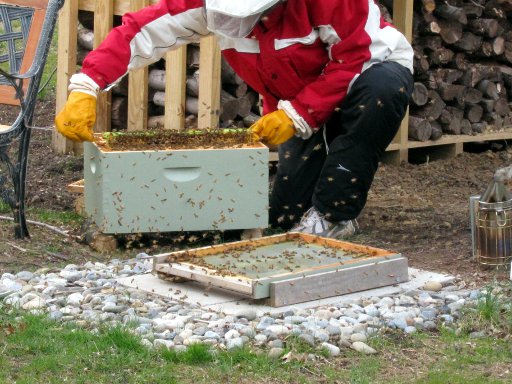
Flipping the Hive Boxes
I can't believe it's the new year already! Where did 2011 go?!
I do have a lot of photographs from the past year and, judging from them, it sure looks like we were busy here. Wait! I have an idea. Let's see if I can string some words together for these pictures and try to recreate 2011 from memory. And along the way, we can answer questions like...
So for answers to these questions and more, please keep reading!!

Flipping the Hive Boxes
A new Spring task for this year was switching the lower 2 brood boxes in the beehive. But why would anyone do such a crazy thing?
Well... over the Winter and into early Spring, the cluster of bees often move into the top box as they follow the food supply and warmth. However, this may cause the bees to think they are running out of space. Further, the queen may avoid going down to the lower box while it's still cool at night. This make sense... I mean, who wants to hang out in their basement during the Winter?
So then, on a warm Spring day, you're supposed to take apart the hive and determine where the bees are hanging out. And if they are mostly in the top of the hive, you switch the bottom and top boxes! And yes, it certainly felt strange taking apart the hive while they're all buzzing around. But they settled back down just as soon as I was done and this was a good opportunity to clean up that bottom board too. Note that, for this particular task, I am wearing a snowsuit since I never bothered to buy the whole beekeepers outfit!
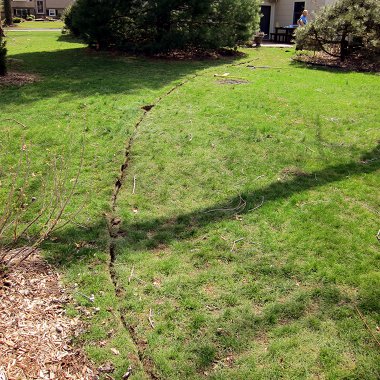

Irrigating the Orchard
Some of you may remember from last year, that New Jersey suffered the 10th driest Summer in over a century?
Well... during that time, I had to carry a lot of water to plants and some younger trees around the yard. So this year, the project at the top of my list was to run an irrigation line out past the shed and down to the 2 apple trees. My kids did all the digging here, so I just had to follow behind them and sink the polyethylene pipe.
But as with most projects, the scope of this one expanded to include:
As for the burgeoning orchard itself? We'll have more on that later in this update!

Pond in Spring
You've seen pictures from this angle before. And now I'll let you in on a little secret: this is one of my favorite lunch locations! In the Spring, you can often find me here, in a reclining chair, having lunch. And while I cannot remember what that violet flowering ground cover in front of the bridge is called, it sure does seem happy there!
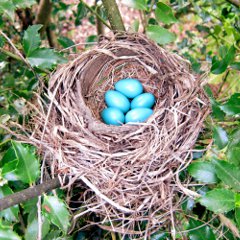
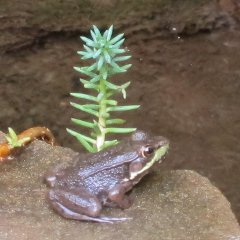
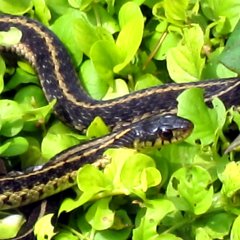
Critters
All our friends have returned! Alas, not everyone was glad to see the pair of snakes again... but they only stay for a week or so before moving on.
And yes, that is the same frog from last year! He (or she) overwintered here and is now very tame. I was a concerned that the snakes would get him, but apparently the frog is only tame when it comes to people. The only time I ever made this frog jump into the pond was when I nearly stepped on him! After that, I learned to be more careful about where I put my feet.
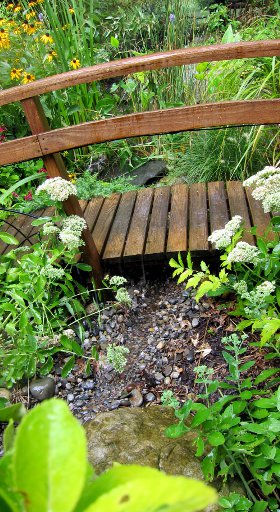
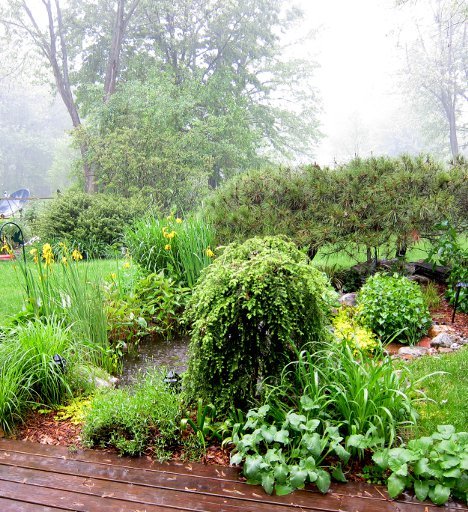
Record Rainfall in 2011
The drought is over! This year New Jersey saw over 60 inches of rain which made for the wettest year in history (or, at least, going back to 1895 when they started keeping records). You can always tell when it's raining hard because there is water running out of the pond and under the bridge. And as you probably guessed, I did not get much use out of the new irrigation line this year!
The wettest month was August, when Hurricane Irene came through New Jersey. On Sunday August 28th, around 2AM Sunday morning, I walked into the back yard with a flashlight to discover that everything beyond the Japanese Pine behind the pond was now under water... our back yard was a huge lake!! The water was also up a couple inches into the beehive. I have never seen anything like this and there was nothing I could do. Unfortunately, I do not a picture to share; I wish I could share the one forever engrained in my head because it was so unbelievable.
As for the bees, by the next morning, the water had receded and they were hard at work cleaning up and bringing out the dead. Then later in the Fall, I raised the hive up on another set of cinder blocks to keep them out of harms way should this ever happen again.

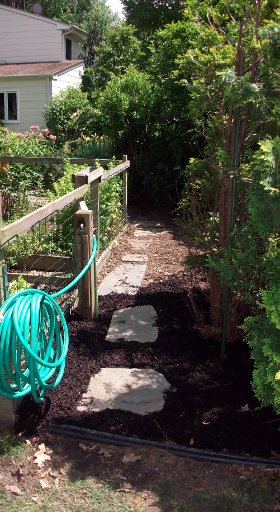
Clearing a Path
With each passing year, it became more difficult to walk to the garden because the beautiful Ilex Verticillata kept encroaching on the stone path. Pruning was no longer enough because this thing is thicket-forming and loves to spread, especially in wet soil. It even came up in the garden! To solve this problem, I dug up all the roots and then buried a wall of pressure-treated wood 12 inches down into the ground; yeah, I'd like to see those roots get past that barrier! As you can see, there's now an easy-to-maintain edge around that corner. Oh! And on the right, you can see our milkweed preparing for another crop of Monarch Caterpillars!
Alas, this project grew in scope too. Let me explain. Picture yourself walking that path out to the garden. Now the problem is, once you reach it, there is nowhere else to go... it's a dead end! Sure, you could hop the split-rail fence (center of first photo) to get out to the back yard and beehive, but that Lilac bush is getting bigger making the leap difficult. I then had an inspiration! What if I remove one of the 3 arborvitaes next to the garden and continue the path? Before I gave it too much thought, I had a shovel in my hand and had transplanted the arborvitae!
There in the second photo, you can see the result... perfect! I later added another path light to this entrance to give the path a sense of continuity. And now, it's very easy to walk out to the garden and, if one feels like it, out to the beehive and beyond!
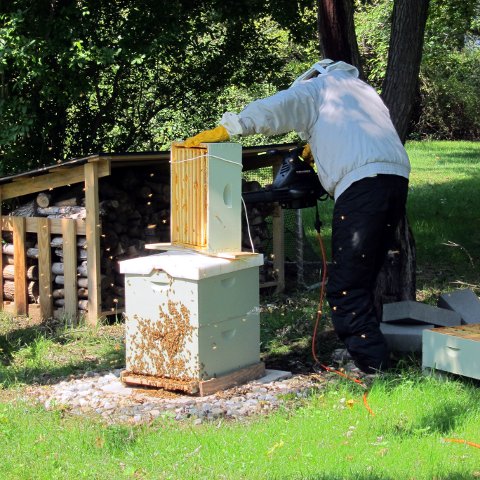
Removing the Honey Supers
And speaking of that beehive... it's time to remove the top 2 honey supers and see if the bees made any extra honey for us. The top box was mostly empty, but the next box was completely full of capped honey! This was ours!!
In this photo, I'm using a leaf blower to flush the bees from the honey super. This was as strange as it looked, but the bees seemed to take it in stride; they flew out into the air, turned around and and returned to the hive. If I had planned ahead, I would have ordered a bee escape board (which I now have)... so next time I do this, there should be fewer bees in the honey supers. Since my youngest son was going to help me extract the honey, I just wanted to be sure that I got as many bees out as I could.
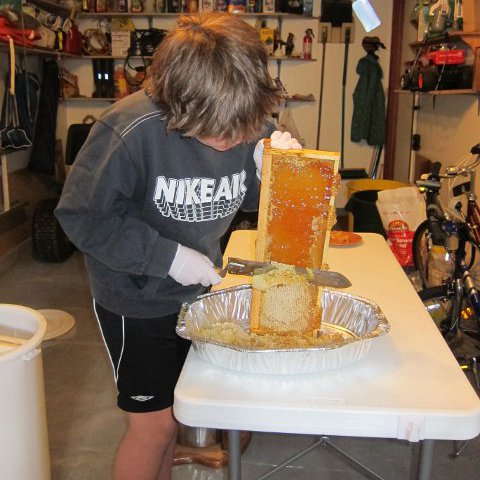
Uncapping the Honey
And here is my youngest son removing the wax caps from a frame of honey! The bees only cap a honeycomb when it's finished, so if you have a fully-capped frame, you know it's all honey!
Every time he uncapped 2 frames, it was my job to place them in the extractor (the plastic container in the lower left corner of this photo). The extractor is a simple centrifuge with a hand crank; the first time I tried to spin out the honey, I ran it too fast and some of the comb broke away from the frame. This turned out to be a good thing though, because we just put that honeycomb in our mouth and drank the honey!
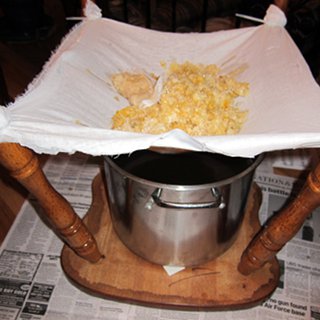
Getting Every Last Drop
My wife gave me this idea, which she got from her mom. Take an old chair, turn it upside down, and stretch some cheesecloth across the legs. Now place all the wax caps on the cheese cloth to get every last drop of honey!
Incidentally, cleanup is really easy. Just take all the equipment out into the yard... the bees will find it and clean it for you! As for the empty frames and honey supers, I put those back on top of the hive and let the bees clean them out. They even started repairing the frame with the broken honeycomb!
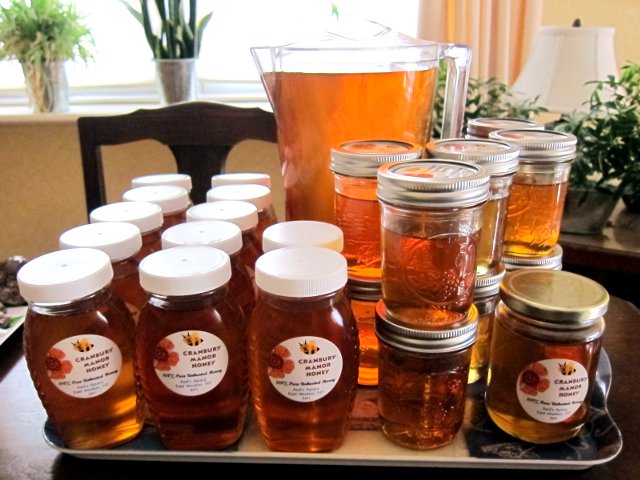
2 1/2 Gallons of Delicious Honey!
At the end of the day, we had extracted 2.5 gallons of honey, which we shared with family, friends and neighbors. The sample jars on the right were given to our wonderful neighbors, while my son sold the jars on the left. And that big pitcher in the back? Well, we had to keep some for ourselves, right?!
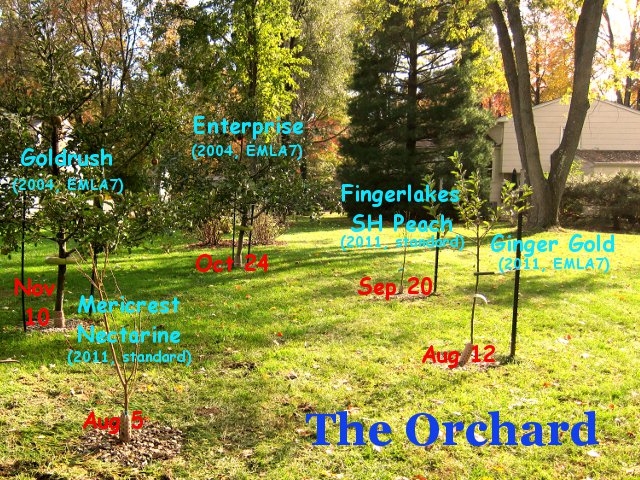
Meanwhile, at the Orchard...
Here's how the orchard looked in the Fall. The names of the trees are in light blue (along with the year planted and rootstock), while the expected harvest date is in red. Yeah, okay... I really took this picture and labeled it so I could remember this stuff!
The two apple trees from 2004 produced a bushel of delicious apples. So this year, we ordered a few more trees from Miller Nurseries! We added one peach tree, a nectarine, and one more apple (that ripens earlier in the season).
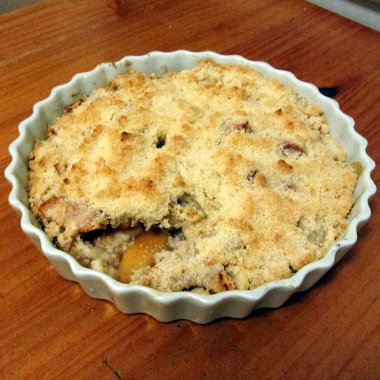
Making Good Use of the Apples!
So what to do with all those apples? Well, my wife came up with an excellent idea here: APPLE PIE!! I recommend these served warm, with a scoop of ice cream on the side!
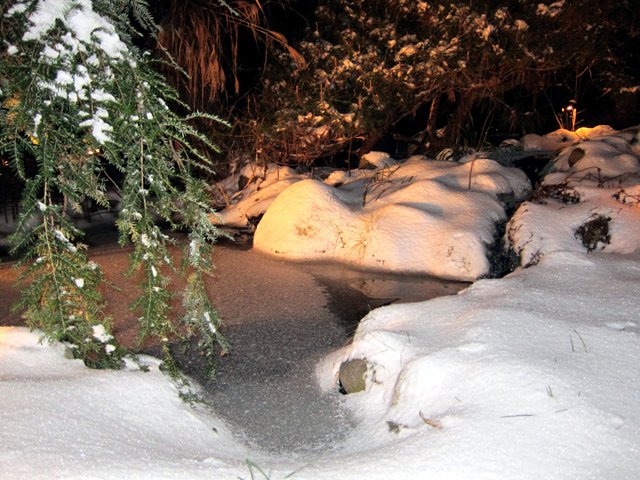
And Then Winter Arrives... Late!
We finally got our first snowfall of the season on January 21, 2012!
This has been a very mild Winter. I've only had to use the pond heater on a few cold nights, and we're still feeding the fish a couple times a week. As of today though, that pond heater is back on and the fish will have to go hungry!

